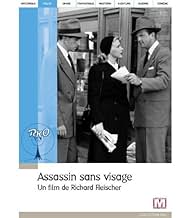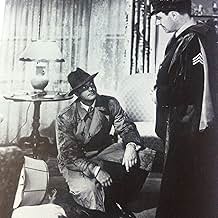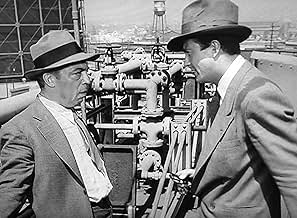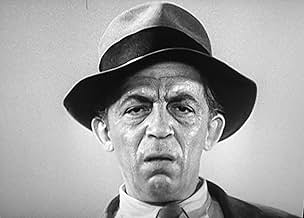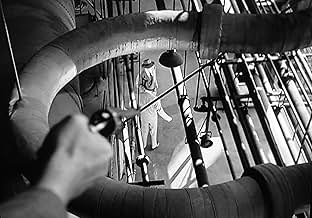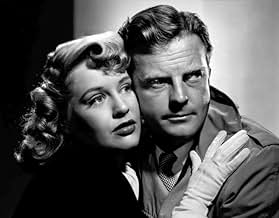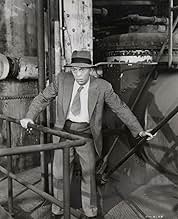NOTE IMDb
6,5/10
2,1 k
MA NOTE
Ajouter une intrigue dans votre langueAn obsessed cop tracks an elusive serial killer who strangles his victims on rainy nights.An obsessed cop tracks an elusive serial killer who strangles his victims on rainy nights.An obsessed cop tracks an elusive serial killer who strangles his victims on rainy nights.
- Réalisation
- Scénario
- Casting principal
Archie Twitchell
- Dixon
- (as Michael Branden)
Fred Aldrich
- Detective at Briefing
- (non crédité)
Walden Boyle
- Intern
- (non crédité)
Paul Bryar
- Sgt. Bryce
- (non crédité)
Wanda Cantlon
- Waitress
- (non crédité)
Maurice Cass
- Bookstore Owner
- (non crédité)
Martin Cichy
- Cop
- (non crédité)
Art Dupuis
- Detective
- (non crédité)
Avis à la une
Follow Me Quietly is directed by Richard Fleischer (with uncredited help from Anthony Mann) and adapted to screenplay by Lillie Hayward from a story written by Mann and Francis Rosenwald. It stars William Lundigan, Dorothy Patrick, Jeff Corey, Nestor Paiva and Paul Guilfoyle. Music is by Leonid Raab and cinematography by Robert De Grasse.
A serial killer known as "The Judge" is stalking the city, his modus operandi is to strike when it rains and to kill by strangulation. The police have loads of little clues but nothing solid to go on. The strain is starting to weigh heavy on Lt. Harry Grant (Lundigan), but he comes up with a genius idea to help catch the killer - a mannequin!
Not widely known, but once released to MOD home format it got more noticed and has been keenly sought out by fans of the great Anthony Mann. It has proved a little divisive so this fawning review should be taken with a little context. Clocking in at just under an hour in length, Fleischer's film is by definition a compact RKO "B" picture, but the quality of story, and the little slices of noir craft, ensure it's got plenty of strengths going for it.
In essence it's an early police procedural dealing with the hunt for a serial killer. There's a babe in the mix, Dorothy Patrick as an intrepid reporter who announcers herself to the film wearing a see through mackintosh, which of course is splendid. She teams up with Grant, not as a fatale, but as a sort of wry cohort, suggestion is evident, sexual tension even, but nothing is shoe-horned in to the pic. The cops are all stoic types, splendidly attired for period delights, but it's with Lundigan's head of investigations where the film gets its pulse beat. He gets in deep with the psychological aspects of the case, thinking like the killer, talking to the faceless mannequin that has been constructed out of clues left by the killer, the mirror images of the killer and mannequin are not exactly a million miles away from Lundigan himself. Cheeky is that.
Mann's stamp is all over the film, but Fleischer's work is evident for sure, an economical purist meets the crafty auteur, a fine match. Robert De Grasse (The Body Snatcher/Born to Kill) is a key component, operating with angles and shades when required, there's a distinct uneasy feel to proceedings. A few scenes grab the attention with full effect, akin to a spider inviting a fly to dinner, which all builds to a head, culminating in a blunderbuss finale at an oil refinery - cum - power plant. Only where White Heat (also 1949) went nighttime for its coup de grace, Follow Me Quietly did it in daylight. Cheeky is that.
It's not perfect. Some logic holes are there as regards the water effect with the killer, which also leads us to lament a lack of reasoning and understanding with the perpetrator. There's also a couple of instances where the mannequin is played in a rear shot by a real actor, why? I have no idea. While the best scene in the film, as Lundigan chats to the dummy in a darkened room - and the rain falls hard on the windows - brings about a reveal that makes no sense what so ever. Especially once "The Judge" is revealed. However, this is easy to recommend to noir heads and fans of police procedurals, and I loved it. 8/10
A serial killer known as "The Judge" is stalking the city, his modus operandi is to strike when it rains and to kill by strangulation. The police have loads of little clues but nothing solid to go on. The strain is starting to weigh heavy on Lt. Harry Grant (Lundigan), but he comes up with a genius idea to help catch the killer - a mannequin!
Not widely known, but once released to MOD home format it got more noticed and has been keenly sought out by fans of the great Anthony Mann. It has proved a little divisive so this fawning review should be taken with a little context. Clocking in at just under an hour in length, Fleischer's film is by definition a compact RKO "B" picture, but the quality of story, and the little slices of noir craft, ensure it's got plenty of strengths going for it.
In essence it's an early police procedural dealing with the hunt for a serial killer. There's a babe in the mix, Dorothy Patrick as an intrepid reporter who announcers herself to the film wearing a see through mackintosh, which of course is splendid. She teams up with Grant, not as a fatale, but as a sort of wry cohort, suggestion is evident, sexual tension even, but nothing is shoe-horned in to the pic. The cops are all stoic types, splendidly attired for period delights, but it's with Lundigan's head of investigations where the film gets its pulse beat. He gets in deep with the psychological aspects of the case, thinking like the killer, talking to the faceless mannequin that has been constructed out of clues left by the killer, the mirror images of the killer and mannequin are not exactly a million miles away from Lundigan himself. Cheeky is that.
Mann's stamp is all over the film, but Fleischer's work is evident for sure, an economical purist meets the crafty auteur, a fine match. Robert De Grasse (The Body Snatcher/Born to Kill) is a key component, operating with angles and shades when required, there's a distinct uneasy feel to proceedings. A few scenes grab the attention with full effect, akin to a spider inviting a fly to dinner, which all builds to a head, culminating in a blunderbuss finale at an oil refinery - cum - power plant. Only where White Heat (also 1949) went nighttime for its coup de grace, Follow Me Quietly did it in daylight. Cheeky is that.
It's not perfect. Some logic holes are there as regards the water effect with the killer, which also leads us to lament a lack of reasoning and understanding with the perpetrator. There's also a couple of instances where the mannequin is played in a rear shot by a real actor, why? I have no idea. While the best scene in the film, as Lundigan chats to the dummy in a darkened room - and the rain falls hard on the windows - brings about a reveal that makes no sense what so ever. Especially once "The Judge" is revealed. However, this is easy to recommend to noir heads and fans of police procedurals, and I loved it. 8/10
Follow Me Quietly (1949)
*** (out of 4)
Exciting film noir from RKO has a detective (William Lundigan) trying to track down a mysterious killer known as "The Judge". I haven't heard too many film noir lovers mention this film but I found it to be very tense and brilliantly directed. The film only runs 59-minutes but there's a lot of style throughout each one of them. The ending is full of action and some nice suspense. The film runs at a very fast pace and is over before you know it but for the life of me I can't figure out why this film isn't talked about more. Certainly worth checking out if you can catch it on TCM.
*** (out of 4)
Exciting film noir from RKO has a detective (William Lundigan) trying to track down a mysterious killer known as "The Judge". I haven't heard too many film noir lovers mention this film but I found it to be very tense and brilliantly directed. The film only runs 59-minutes but there's a lot of style throughout each one of them. The ending is full of action and some nice suspense. The film runs at a very fast pace and is over before you know it but for the life of me I can't figure out why this film isn't talked about more. Certainly worth checking out if you can catch it on TCM.
"Follow Me Quietly" is an atmospheric noir about a police detective on the hunt for a serial strangler.
The film's most memorable plot device is a dummy that the police department has made based on the limited information they've been able to capture about the killer. They know roughly his height, weight, hair color, the color of his suit, etc., and they construct a mannequin that approximates his appearance. They then wrangle up crooks and bring them into police lineups with the dummy to see if any of them look alike. It's actually pretty humorous and doesn't seem like the makings of crack detective work, but it does allow for some rather creepy scenes, and one in particular, when the police detective has an entire conversation with what he thinks is the mannequin, and which the audience finds out is the actual killer after the detective has left the room.
If you're a fan of rain-soaked streets and movies whose titles have nothing to do with what they're actually about, you'll like this one.
Grade: B+
The film's most memorable plot device is a dummy that the police department has made based on the limited information they've been able to capture about the killer. They know roughly his height, weight, hair color, the color of his suit, etc., and they construct a mannequin that approximates his appearance. They then wrangle up crooks and bring them into police lineups with the dummy to see if any of them look alike. It's actually pretty humorous and doesn't seem like the makings of crack detective work, but it does allow for some rather creepy scenes, and one in particular, when the police detective has an entire conversation with what he thinks is the mannequin, and which the audience finds out is the actual killer after the detective has left the room.
If you're a fan of rain-soaked streets and movies whose titles have nothing to do with what they're actually about, you'll like this one.
Grade: B+
I finally found this movie on video and enjoyed it immensely. I think the other reviewers are missing the point of this movie. They criticize the scene where the killer replaces a dummy of himself in the detective's office and no one notices the difference. This scene to me displays the imagination of the director, who went on to do "The Armored Car Robbery" and the original "Narrow Margin". These B movies are designed for entertainment, not for realism and beat the pants off of most of the junk put out today. So sit back and enjoy the ride!
I've been on a film noir fix lately & finding these flicks on You Tube such as Private Hell 36, Crime Of Passion, The Killer Is Loose, Please Murder Me, Raw Deal, Black Angel etc. Most of these I enjoyed & I've watched them once but when I stumbled onto this one yesterday I watched it again today as it was a little more than what I expected. Follow Me Quietly is not really a film noir it's a crime drama & police procedural.
It's a bit experimental & unusual which makes it stand out from the others, the late 40's post war period was a time when filmmakers were trying out new gimmicks such as subjective first person camera like Lady In The Lake (1946) & Dark Passage (1947). The police create a dummy of the killer from what evidence & clues they have which is a little more than the usual routine bulletin description of a suspect.
Sometimes a person can be identified & recognized by the back of their head & ears & the size & shape of their body & physique. Since the police have never seen the killers face the dummy is faceless & startling. The scene where the killer replaces the dummy & sits in William Lundigan's office facing the window with it's back to him is clever but pointless & foolish. What if the detective was smart enough to notice it was really him ? Why would the killer take such a risk ? I think it was just a gimmick & for cinematic effect to satisfy the filmmakers & to give the audience a thrill. The silly trick worked & fooled me I thought it was the faceless dummy.
And when the killers face is revealed he's not what you expect, he's very insecure & nervous & seems incapable of doing anything right. How did he manage to kill 8 victims & get away with it ? The ending is similar to White Heat & this film isn't great but it's fun & interesting, different & memorable & worth watching. I've seen it twice & I may watch it again.
It's a bit experimental & unusual which makes it stand out from the others, the late 40's post war period was a time when filmmakers were trying out new gimmicks such as subjective first person camera like Lady In The Lake (1946) & Dark Passage (1947). The police create a dummy of the killer from what evidence & clues they have which is a little more than the usual routine bulletin description of a suspect.
Sometimes a person can be identified & recognized by the back of their head & ears & the size & shape of their body & physique. Since the police have never seen the killers face the dummy is faceless & startling. The scene where the killer replaces the dummy & sits in William Lundigan's office facing the window with it's back to him is clever but pointless & foolish. What if the detective was smart enough to notice it was really him ? Why would the killer take such a risk ? I think it was just a gimmick & for cinematic effect to satisfy the filmmakers & to give the audience a thrill. The silly trick worked & fooled me I thought it was the faceless dummy.
And when the killers face is revealed he's not what you expect, he's very insecure & nervous & seems incapable of doing anything right. How did he manage to kill 8 victims & get away with it ? The ending is similar to White Heat & this film isn't great but it's fun & interesting, different & memorable & worth watching. I've seen it twice & I may watch it again.
Le saviez-vous
- AnecdotesFilmed in only sixteen days.
- GaffesWhen Detective Grant is in the office trying to solve the serial killings; he begins talking to the "Judge" dummy that is sitting on a chair with its back turned to him. After Collins interrupts him and they both leave the office; the dummy comes to life. It turns out that the real killer hid the dummy and took its place sitting on the chair. The puzzling thing is that the film does not explain how the killer manages to enter the Police precinct and the Detective's office without being detected. In addition, why would the killer want to go there and how did the killer in the first place even know the existence of a lookalike dummy. Finally, Detective Grant has been practically living with this dummy so it makes no sense that he couldn't tell even from the back that it was a real human being there. All these factors briefly interrupted the flow of the story.
- Citations
Lt. Harry Grant: Funny thing how he always strikes in the rain.
Sgt. Art Collins: Maybe he likes rain. Must be a fish.
- ConnexionsFeatured in Armored Car Robbery (1950)
Meilleurs choix
Connectez-vous pour évaluer et suivre la liste de favoris afin de recevoir des recommandations personnalisées
Détails
- Date de sortie
- Pays d’origine
- Langue
- Aussi connu sous le nom de
- Sigueme en silencio
- Lieux de tournage
- Société de production
- Voir plus de crédits d'entreprise sur IMDbPro
- Durée1 heure
- Couleur
- Rapport de forme
- 1.37 : 1
Contribuer à cette page
Suggérer une modification ou ajouter du contenu manquant

Lacune principale
By what name was L'assassin sans visage (1949) officially released in India in English?
Répondre

